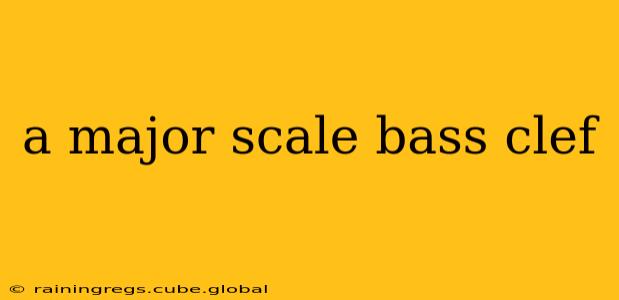The A major scale in bass clef is a fundamental concept in music theory, essential for any bassist, composer, or musician working with lower register instruments. This comprehensive guide delves into the construction of the A major scale in bass clef, exploring its intervals, practical applications, and common challenges encountered by learners. We'll address frequently asked questions to ensure a complete understanding.
What are the notes of the A major scale in bass clef?
The A major scale consists of seven notes, arranged in a specific pattern of whole and half steps. In bass clef, the notes of the A major scale are: A, B, C#, D, E, F#, and G#. These notes are played in ascending order. Let's break down the intervallic structure:
- Whole Step: A to B (2 semitones)
- Whole Step: B to C# (2 semitones)
- Half Step: C# to D (1 semitone)
- Whole Step: D to E (2 semitones)
- Whole Step: E to F# (2 semitones)
- Whole Step: F# to G# (2 semitones)
- Half Step: G# to A (1 semitone)
This W-W-H-W-W-W-H pattern is characteristic of major scales. It's crucial to remember this pattern, as it forms the basis for understanding major scales in all keys.
How do I play the A major scale on the bass guitar?
Playing the A major scale on the bass guitar depends on your preferred fingering and the range you want to cover. There isn't a single "correct" way, but rather several effective approaches. Beginners often focus on a single octave, while more experienced players might extend the scale across multiple octaves. The best approach is to practice different fingerings and find what feels most comfortable and efficient for you. Consider focusing on smooth transitions between notes and maintaining consistent rhythm.
What is the key signature of A major?
The key signature of A major contains three sharps: F#, C#, and G#. This means that these notes are always raised by a half step when playing in the key of A major. Understanding key signatures is vital for quickly identifying the notes within a scale and for reading music fluently.
What are some common mistakes when playing the A major scale in bass clef?
A common mistake is miscounting the intervals or accidentally playing the wrong notes due to the sharps. Consistent practice and attention to detail are key to avoiding these errors. Another mistake lies in inconsistent rhythm and fingering. Practicing with a metronome and experimenting with different fingerings helps to build dexterity and improve accuracy.
How is the A major scale used in music?
The A major scale is widely used in various musical genres, offering a bright and uplifting sound. It's frequently found in classical, jazz, pop, and rock music, serving as a foundation for melodies, harmonies, and improvisations. Its prevalence stems from its pleasing sound and the relative ease with which it can be incorporated into various musical contexts. Many popular songs utilize A major chords and melodies, making it a crucial scale for aspiring bassists to master.
Where can I find exercises for practicing the A major scale?
Many websites, books, and apps offer bass guitar exercises specifically designed to help you learn the A major scale. Searching for "bass guitar A major scale exercises" will yield numerous results catering to various skill levels. A methodical approach, focusing on small sections of the scale before moving to the full scale, is recommended.
Mastering the A major scale in bass clef is a significant step in developing your musical abilities. Through consistent practice and attention to detail, you'll not only improve your technical skills but also enhance your musical understanding and creativity. Remember to practice slowly and accurately, gradually increasing your speed as you build proficiency. Consistent effort and mindful practice are the keys to success.
